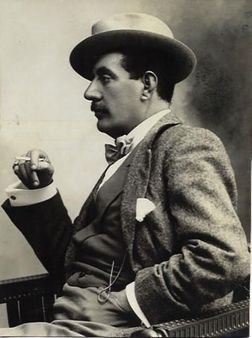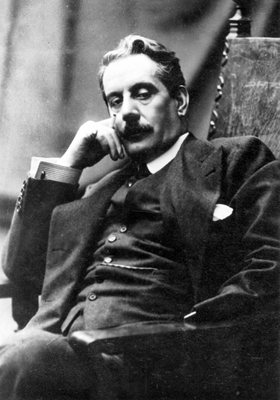<Back to Index>
- Composer Giacomo Puccini, 1858
PAGE SPONSOR
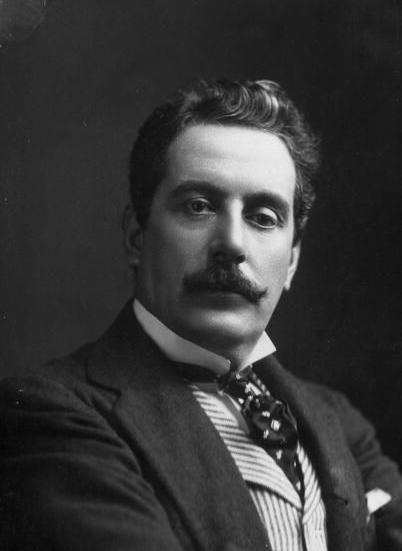
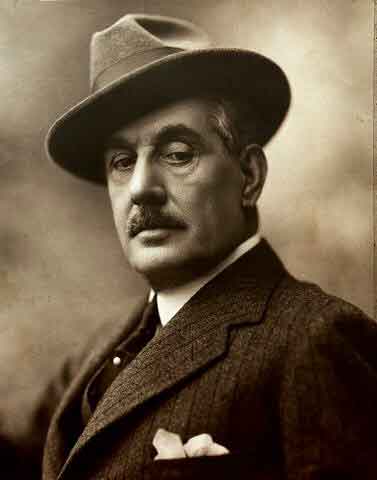
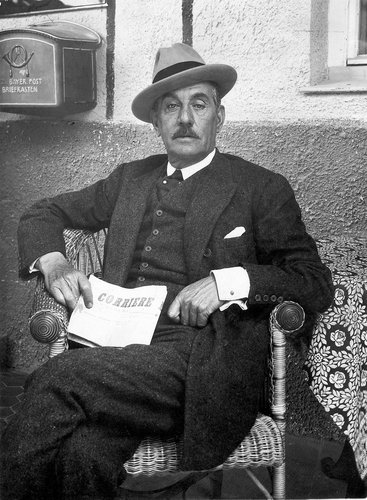
Giacomo Puccini (full name: Giacomo Antonio Domenico Michele Secondo Maria Puccini) (22 December 1858 - 29 November 1924) was an Italian composer whose operas are among the most frequently performed in the standard repertoire.
Puccini was "the greatest composer of Italian opera after
Verdi".
While his early work was rooted in traditional late 19th
century romantic Italian opera, he successfully developed
his work in the 'realistic' verismo style, of
which he became one of the leading exponents.
Puccini was born in Lucca in Tuscany, in 1858. He was one of seven children of Michele Puccini and Albina Magi. The Puccini family was established in Lucca as a local musical dynasty by Puccini's great - great grandfather – also named Giacomo (1712 - 1781). This first Giacomo Puccini was maestro di cappella of the Catedrale di San Martino in Lucca. He was succeeded in this position by his son, Antonio Puccini, and then by Antonio's son Domenico, and Domenico's son Michele (father of the subject of this article). Each of these men studied music at Bologna, and some took additional musical studies elsewhere. Domenico Puccini studied for a time under Giovanni Paisiello. Each composed music for the church. In addition, Domenico composed several operas, and Michele composed one opera. Puccini's father Michele enjoyed a reputation throughout northern Italy, and his funeral was an occasion of public mourning, at which the then famed composer Giovanni Pacini conducted a Requiem.
With the Puccini family having occupied the position of maestro di cappella for 124 years (1740 - 1864) by the time of Michele's death, it was anticipated that Michele's son Giacomo would occupy that position as well when he was old enough. However, when Michele Puccini died in 1864, his son Giacomo was only six years old, and thus not capable of taking over his father's job. As a child, he nevertheless participated in the musical life of the Catredale di San Martino, as a member of the boys' choir and later as a substitute organist.
Puccini was given a general education at the seminary of San Michele in Lucca, and then at the seminary of the cathedral. One of Puccini's uncles, Fortunato Magi, supervised his musical education. Puccini got a diploma from the Pacini School of Music in Lucca in 1880, having studied there with his uncle Fortunato, and later with Carlo Angeloni, who had also instructed Alfredo Catalani. A grant from the queen of Italy, and assistance from another uncle, Nicholas Cerù, provided the funds necessary for Puccini to continue his studies at the Milan Conservatory, where he studied composition with Stefano Ronchetti - Monteviti, Amilcare Ponchielli and Antonio Bazzini. Puccini studied at the conservatory for three years. In 1880, at the age of 21, Puccini composed his Mass, which marks the culmination of his family's long association with church music in his native Lucca.
As something in the nature of a thesis composition for the Milan Conservatory, Puccini wrote an orchestral piece called the Capriccio sinfonica. Puccini's teachers Ponchielli and Bazzini were impressed by the work. The Capriccio sinfonica was performed at a student concert at the conservatory, and Puccini's work was favorably reviewed in a Milanese publication Perseveranza. Thus Puccini began to build a reputation as a young composer of promise in Milanese music circles.
After the premiere of the Capriccio sinfonica, Ponchielli and Puccini discussed the possibility that Puccini's next work might be an opera. Ponchielli invited Puccini to stay at his villa, where Puccini was introduced to another young man named Fernando Fontana. Puccini and Fontana agreed to collaborate on an opera, for which Fontana would provide the libretto. The work, Le villi, was entered into a competition sponsored by the Sozogno music publishing company in 1883 (the same competition in which Pietro Mascagni's Cavalleria rusticana was the winner in 1889). Although it did not win, Le villi was later staged at the Teatro Dal Verme, premiering on May 31, 1884. G. Ricordi & Co. music publishers, assisted with the premier by printing the libretto without charge. Fellow students from the Milan Conservatory formed a large part of the orchestra. The performance was enough of a success that Casa Ricordi purchased the opera. Revised to a two-act version with an intermezzo between the acts, Le villi was performed at La Scala in Milan, on 24 January 1885. Ricordi did not publish the score until 1887, however, hindering further performance of the work.
Giulio Ricordi, head of G. Ricordi & Co. music publishers, was sufficiently impressed with Le villi and its young composer that he commissioned a second opera, which turned out to be Edgar. Work was begun in 1884, when Fontana began working out the scenario for the libretto. Puccini finished primary composition in 1887, and orchestration in 1888. Edgar premiered at La Scala on April 21, 1889 to a lukewarm response. The work was withdrawn for revisions after its third performance. In a Milanese newspaper, Giulio Ricordi published a defense of Puccini's skill as a composer, while criticizing Fontana's libretto. A revised version met with success at the Teatro di Giglio in Puccini's native Lucca on September 5, 1891. In 1892, further revisions reduced the length of the opera to three acts from four, in a version that was well received in Ferrara and was performed in Turin and in Spain. Puccini made further revisions in 1901 and 1905, but the work never achieved popularity. But for the personal support of Ricordi, Edgar might have cost Puccini his career. Puccini had eloped with his former piano student, the married Elvira Gemignani, and Ricordi's associates were willing to turn a blind eye to his life style as long as he was successful. When Edgar failed, they suggested to Ricordi that he should drop Puccini, but Ricordi said that he would stay with him and made him an allowance from his own pocket until his next opera.
On commencing his next opera, Manon Lescaut,
Puccini announced that he would write his own libretto so
that "no fool of a librettist" could spoil it. Ricordi
persuaded him to accept Ruggero Leoncavallo as his
librettist, but Puccini soon asked Ricordi to remove him
from the project. Four other librettists were then
involved with the opera, as Puccini constantly changed his
mind about the structure of the piece. It was almost by
accident that the final two, Luigi Illica and Giuseppe
Giacosa, came together to complete the opera. They
remained with Puccini for his next three operas and
probably his greatest successes: La bohème, Tosca
and Madama Butterfly. Manon Lescaut was a
great success and established Puccini's reputation as the
most promising rising composer of his generation, and the
most likely "successor" to Verdi as the leading exponent
of the Italian operatic tradition.
Puccini's next work after Manon Lescaut was La bohème, based on the 1851 book by Henri Murger, La Vie de Bohème. La bohème was premiered in Turin in 1896, conducted by Arturo Toscanini. The opera quickly became popular throughout Italy and productions were soon mounted all over the world.
The opera freely adapted Murger's episodic novel into a four-act opera focusing on six young bohemians in Paris. The libretto of the opera combines comic elements of the impoverished life of the young protagonists of the opera with the tragic aspects, such as the death of Mimí. The world premiere performance of La bohème was in Turin on 1 February 1896 at the Teatro Regio and conducted by the young Arturo Toscanini.
Puccini's own life as young man in Milan served as a source of inspiration for elements of the libretto. During Puccini's years as a conservatory student and in the years before Manon Lescaut, Puccini experienced poverty similar to that of the bohemians in La bohème, including chronic shortage of necessities like food, clothing and money to pay rent. Although Puccini was granted a small monthly stipend by the Congregation of Charity in Rome (Congregazione di caritá), he frequently had to pawn possessions in order to cover basic expenses. Indeed, early biographers of Puccini such as Wakeling Dry and Eugenio Checchi, who were his contemporaries, drew express parallels between these incidents and particular events in the opera La bohème. Checchi cited a diary kept by Puccini while he was still a student, which the young man titled "Bohemian Life, 1881. Record of Expenses" (La vie de boheme, Registro di spese), in which Puccini recorded the amounts spent on meager supplies of basics like milk and bread. This diary recorded one occasion on which Puccini purchased a single herring, which served as a dinner for four people: Puccini, his brother Michele, their roommate (a cousin), and a friend. Commenting on this incident, Puccini stated: "Doesn't it seem to you like the first scene of act four of my Bohème? I lived that Bohème, when there wasn't yet any thought stirring in my brain of seeking the theme of an opera. (Non ti pare la prima scena del quarto atto della mia Bohème? Quella Bohème io l’ho vissuta, quando ancora non mi mulinava nel cervello l’idea di cercarvi l’argomento per un’opera in musica.)" In the first scene in act 4, the characters Schaunard and Colline bring dinner to the garrett, consisting of "un piatto degno di Demostene: un 'aringa ... salata" (a dish worthy of Demosthenes: a salted herring), which, with bread, serves as a meal for four. Dry and Checchi cite several other examples of incidents from Puccini's impoverished early adult years that have direct parallels in the libretto of La bohème.
Within a few years, La bohème had been performed throughout many of the leading opera houses of Europe, including Britain, as well as in the United States. It was a popular success, and remains one of the most frequently performed operas ever written.
Puccini's next work after La bohème was Tosca (1900), arguably Puccini's first foray into verismo, the realistic depiction of many facets of real life including violence. Puccini had been considering an opera on this theme since he saw the play Tosca by Victorien Sardou in 1889, when he wrote to his publisher, Giulio Ricordi, begging him to get Sardou's permission for the work to be made into an opera: "I see in this Tosca the opera I need, with no overblown proportions, no elaborate spectacle, nor will it call for the usual excessive amount of music."
On February 25, 1903, Puccini was seriously injured in a car accident during a nighttime journey on the road from Lucca to Torre del Lago. The car, driven by Puccini's chauffeur, and carrying Puccini, his wife Elvira, and their son Antonio. The car went off the road, fell several meters, and flipped over. Elvira and Antonio were flung from the car and escaped with minor injuries. Puccini's chauffeur, also thrown from the car, suffered a serious fracture of his femur. Puccini was pinned under the car, with a severe fracture of his right leg, and with a portion of the car pressing down on his chest. A doctor that lived near the scene of the accident, together with another person who came to investigate, saved Puccini from the wreckage. The injury did not heal well, and Puccini remained under treatment for months. The accident and its consequences slowed Puccini's completion of his next work, Madama Butterfly.
The original version of Madama Butterfly, premiered at La Scala on February 17, 1904, was initially greeted with great hostility (probably largely owing to inadequate rehearsals). This version was in two acts; after its disastrous premiere, Puccini withdrew the opera, revising it for performances in the USA and Paris. In 1907, Puccini made his final revisions to the opera in a fifth version, which has become known as the "standard version". Today, the standard version of the opera is the version most often performed around the world. However, the original 1904 version is occasionally performed as well, and has been recorded.
After 1904, Puccini's compositions were less frequent. In 1906 Giacosa died and, in 1909, there was scandal after Puccini's wife, Elvira, falsely accused their maid Doria Manfredi of having an affair with Puccini. Finally, in 1912, the death of Giulio Ricordi, Puccini's editor and publisher, ended a productive period of his career.
Puccini completed La fanciulla del West, based
on a play by David Belasco, in 1910. This was commissioned
by, and first performed at, the Metropolitan Opera in New
York on 10 December 1910 with Met stars Enrico Caruso and
Emmy Destinn for whom Puccini created the leading roles of
Dick Johnson and Minnie. Toscanini, then the musical
director of the Met, conducted. This was the first
world premiere of an opera at the Met. The premiere was a
great success. However, the compositional style employed
in the opera, with few stand-alone arias, was criticized
at the time and remains a barrier to the opera's complete
acceptance into the standard repertoire. Some
contemporaries also criticized the opera for failing to
achieve an "American" tone. However, the opera
has been acclaimed for its incorporation of advanced
harmonic language and rhythmic complexity into the Italian
operatic form. In addition, one aria from the opera,
Ch'ella mi creda, has become a staple of compilation
albums by operatic tenors. It is said that during World
War I, Italian soldiers sang this aria to maintain their
spirits.
Puccini completed the score of La rondine, to a libretto by Giuseppe Adami in 1916 after two years of work, and it was premiered at the Grand Théâtre de Monte Carlo on 27 March 1917. The opera had been originally commissioned by Vienna's Carltheater; however the outbreak of World War I prevented the premiere being given there. Moreover, the firm of Ricordi had declined the score of the opera, which had been taken up by their rival, Lorenzo Sonzogno, who arranged the first performance in neutral Monaco. The least known of Puccini's mature operas, the composer continued to work at revising it until his death.
La rondine was initially conceived as an operetta, but Puccini eliminated spoken dialogue, rendering the work closer in form to an opera. A modern reviewer described La rondine as "a continuous fabric of lilting waltz tunes, catchy pop-styled melodies, and nostalgic love music," while characterizing the plot as recycling characters and incidents from works like 'La traviata' and 'Die fledermaus'.
In 1918, Il trittico premiered in New York. This work is composed of three one-act operas: a horrific episode (Il tabarro), in the style of the Parisian Grand Guignol, a sentimental tragedy (Suor Angelica), and a comedy (Gianni Schicchi). Of the three, Gianni Schicchi, containing the popular aria "O mio babbino caro", has remained popular.
Turandot, Puccini's final opera, was left
unfinished, and the last two scenes were completed by
Franco Alfano based on the composer's sketches. The
libretto for Turandot was based on a play by Carlo Gozzi,
also called Turandot.
The music of the opera is heavily inflected with
pentatonic motifs, intended to produce an Asiatic flavor
to the music. Unlike La fanciulla, Turandot
contains a number of memorable stand-alone arias, among
them Nessun dorma.
The libretto of Edgar was a significant factor in the failure of that opera. Thereafter, especially throughout his middle and late career, Puccini was extremely selective, and at times indecisive, in his choice of subject matter for new works. Puccini was deeply involved in the process of writing the libretto itself, requiring many iterative revisions of his libretti in terms of both structure and text. Puccini's relationships with his librettists were at times very difficult. His publisher, Casa Ricordi, was frequently required to mediate disputes and impasses between them.
Puccini explored many possible subjects that ultimately
rejected only after a significant amount of effort — such
as the creation of a libretto — had been put into them.
Among the subjects that Puccini seriously considered, but
abandoned, were: Cristoforo Sly, Anima Allegra
(based on the play El genio alegre by Serafín and
Joaquín Álvarez Quintero), Two Little Wooden Shoes
(I due zoccoletti) (a short story by Maria Louise
Ramé, aka Ouida), the life of Marie Antoinette, Margherita
da Cortona, and Conchita (based on the novel La
Femme et le pantin --The Woman and the Puppet,
by Pierre Loüys). Some of these abandoned subjects were
taken up and turned into operas by other composers. For
example, Franco Vittadini made an opera of Anima
Allegra, Mascagni's opera Lodoletta is
derived from Two Little Wooden Shoes, and Riccardo
Zandonai eventually wrote Conchita (opera).
Today, Puccini is by far the most performed composer among his Italian contemporaries, and the same was true during his lifetime. One contemporary English author, writing in 1897 wrote "[Puccini] is undoubtedly the most fully equipped of the younger Italian composers, and his future career will be watched with some interest." Italian opera composers of the generation with whom Puccini was compared included Pietro Mascagni (Dec. 7, 1863 - Aug. 2, 1945), Ruggero Leoncavallo (b. Naples, Mar. 8 1857; d. Aug. 9, 1919), Umberto Giordano (Aug. 28 1867 - Nov. 12 1948), Francesco Cilea (July 23, 1866 - November 20, 1950), Baron Pierantonio Tasca (1858 - 1934), Gaetano Coronaro (b. Vicenza, Dec. 18 1852; d. Milan, 5 Apr. 5 1908). By the time of his death in 1924, Puccini had earned $4 million from his works.
Eleven of Puccini's operas numbered among the 200 most performed operas between August 2008 and December 2011 (worldwide, by composers of any nationality, as surveyed by Operabase). Only three composers, and three works, by Italian contemporaries of Puccini appear on this list: Cavalleria rusticana by Mascagni, Pagliacci by Ruggero Leoncavallo, and Andrea Chenier by Umberto Giordano).
Puccini is frequently referred to as a "verismo" composer. Verismo is a style of Italian opera that began in 1890 with the first performance of Mascagni's Cavalleria rusticana, peaked in the early 1900s, and lingered into the 1920s. The style is distinguished by realistic – sometimes sordid or violent – depictions of everyday life, especially the life of the contemporary lower classes. It by and large rejects the historical or mythical subjects associated with Romanticism. Cavalleria rusticana, Pagliacci, and Andrea Chenier are uniformly considered to be verismo operas — they represent the primary verismo works in performance today other than those written by Puccini.
Puccini's career as a composer is almost entirely
coincident in time with the verismo movement. Only
his Le villi and Edgar preceded Cavalleria
rusticana. At least two of Puccini's operas, Tosca
and Il tobarro, are generally considered to be verismo
operas. While some view
Puccini as essentially a verismo composer, others,
although acknowledging that he took part in the movement
to some degree, do not view him as a "pure" verismo
composer. In addition, critics differ as to the degree to
which particular operas by Puccini are, or are not,
properly described as verismo operas. For example,
Puccini scholar Mosco Carner places only two of Puccini's
operas other than Tosca and Il tobarro
within the verismo school: Madama Butterfly,
and La fanciulla del West.
In the autumn of 1884, Puccini began a relationship with a married woman named Elvira Gemignani (née Bonturi) in Lucca. Elvira's husband, Narisco Gemignani, was an "unrepentant womanizer", and Elvira's marriage was not a happy one. Elvira became pregnant by Puccini, and their son, Antonio, was born in 1886. Elvira left Lucca when the pregnancy began to show, and gave birth elsewhere to avoid gossip. Elvira, Antonio and Elvira's daughter by Narisco, Fosca began to live with Puccini shortly afterwards. Narisco was killed by the husband of a woman that Narisco had an affair with, dying on February 26, 1903. Only then were Puccini and Elvira able to marry, and to legitimize Antonio.
The marriage between Puccini and Elvira was also troubled by infidelity, as Puccini had frequent affairs himself, including well known singers such as Maria Jeritza, Emmy Destinn, Cesira Ferrani and Hariclea Darclée.
In 1909, Puccini's wife Elvira publicly accused Doria
Manfredi, a maid working for the Puccini family, of having
an affair with the composer. After being publicly accused
of adultery, Doria Manfredi committed suicide. An autopsy
determined, however, that Doria had died a virgin,
refuting the allegations made against her. Elvira Puccini
was prosecuted for slander, and was sentenced to more than
five months in prison. Because of a payment to the
Manfredi family by Puccini, Elvira was spared having to
serve the sentence. According to documents found in the
possession of a descendant of the Manfredi family, Nadia
Manfredi, in 2007, Puccini was actually having an affair
with Giulia Manfredi, Doria's cousin. Press reports at the
time when these documents were discovered alleged that
Nadia Manfredi was Puccini's granddaughter, by a son,
Antonio Manfredi, born to Giulia.
Some music critics and interpreters of Puccini's work have
speculated that the psychological effects of this incident
on Puccini interfered with his ability to complete
compositions later in his career, and also influenced the
development of Puccinian characters such as Liu (from Turandot),
a slave girl who dies tragically by suicide.
From 1891 onwards, Puccini spent most of his time, when not traveling on business, at Torre del Lago, a small community about fifteen miles from Lucca situated between the Ligurian Sea and Lake Massaciuccoli, just south of Viareggio. Torre del Lago was the primary place for Puccini to indulge his love of hunting. "I love hunting, I love cars: and for these things, in the isolation of Torre del Lago, I keep the faith." ("Amo la caccia, adoro l’automobile: e a questo e a quella nelle solitudini di Torre del Lago serbo intera la mia fede.")
By 1900, he had acquired land and built a villa on the lake, now known as the "Villa Museo Puccini." He lived there until 1921, when pollution produced by peat works on the lake forced him to move to Viareggio, a few kilometres north. After his death, a mausoleum was created in the Villa Puccini and the composer is buried there in the chapel, along with his wife and son who died later.
The Villa Museo is presently owned by his granddaughter,
Simonetta Puccini, and is open to the public. An annual
Festival Puccini is held at Torre del Lago.
A chain smoker of Toscano cigars and cigarettes, Puccini began to complain of chronic sore throats towards the end of 1923. A diagnosis of throat cancer led his doctors to recommend a new and experimental radiation therapy treatment, which was being offered in Brussels. Puccini and his wife never knew how serious the cancer was, as the news was only revealed to his son.
Puccini died in Brussels on 29 November 1924, from
complications after the treatment; uncontrolled bleeding
led to a heart attack the day after surgery. News of his
death reached Rome during a performance of La bohème.
The opera was immediately stopped, and the orchestra
played Chopin's Funeral March for the stunned
audience. He was buried in Milan, in Toscanini's family
tomb, but that was always intended as a temporary measure.
In 1926 his son arranged for the transfer of his father's
remains to a specially created chapel inside the Puccini
villa at Torre del Lago.
Unlike Verdi, Puccini was not active in the politics of his day. Puccini biographer Mary Jane Phillips - Matz wrote: "Puccini's interest in politics was close to zero .. all his life. He seemed indifferent to everything from mayoral elections in Viareggio to cabinet appointments in Rome." Another biographer speculates that Puccini may have been — if he had a political philosophy — a monarchist.
Puccini's indifference to politics caused him personal and professional problems during World War I. Puccini's long standing and close friendship with Toscanini was interrupted for nearly a decade because of an argument in the summer of 1914 (in the opening months of the war) during which Puccini remarked that Italy could benefit from German organization. Puccini was also criticized during the war for his work on La rondine, under a 1913 commission contract with an Austrian theater, after Italy and Austria - Hungary became opponents in the war, although the contract was ultimately cancelled. Puccini did not participate in the public war effort, but privately rendered assistance to individuals and families affected by the war.
Puccini had some contact with the Benito Mussolini and the Italian fascist party in the year preceding his death. Unsolicited, in 1923 the fascist party in Viareggio made Puccini an honorary member and sent him a membership card. However, evidence that Puccini was actually a member of the Fascist party is equivocal. The Italian Senate has traditionally included a small number of members appointed in recognition of their cultural contributions to the nation. Puccini hoped to attain this honor, which had been granted to Verdi, and undertook to use his connections to bring about the appointment. While honorary senators could vote, there is no indication that Puccini sought the appointment for this purpose. Puccini also wished to establish a national theater in Viareggio, a project which would require government support. Puccini met with Mussolini twice, in November and December 1923, seeking support for the theater project. While the theater project never came to fruition, Puccini was named Senator (senatore a vita) a few months before his death.
In 1919, Puccini was commissioned to write music to an ode by Fausto Salvatori honoring Italy's victories in World War I. The work, Inno a Roma (Hymn to Rome), was to premiere on April 21, 1919, during a celebration of the anniversary of the founding of Rome. The premiere was delayed to June 1, 1919, when it was played at the opening of a gymnastics competition. Although not written for the fascists, the Inno a Roma was widely played during Fascist street parades and public ceremonies.
At the time Puccini met with Mussolini, Mussolini had
been prime minister for approximately a year, but the his
party had not yet taken full control of the Italian
Parliament through the violence and irregularities of the
Italian general election, 1924. Puccini was no longer
alive when Mussolini announced the end of representative
government, and the beginning of a fascist dictatorship,
in his speech before the Chamber of Deputies on January 3,
1925.
Grove Music Online comments that
Puccini succeeded in mastering the orchestra as no other Italian had done before him, creating new forms by manipulating structures inherited from the great Italian tradition, loading them with bold harmonic progressions which had little or nothing to do with what was happening then in Italy, though they were in step with the work of French, Austrian and German colleagues.
In his work on Puccini, Julian Budden describes Puccini
as a gifted and original composer, noting the vibrant
innovation hidden in the popularity of works such as "Che
gelida manina". He describes the aria in musical terms
(the signature embedded in the harmony for example), and
points out that its structure was rather unheard of at the
time, having three distinct musical paragraphs that
nonetheless form a complete and coherent whole. This
gumption in musical experimentation was the essence of
Puccini's style, as evidenced in his diverse settings and
use of the motif to express ideas beyond those in the
story and text.
Puccini also wrote orchestral pieces, sacred music, chamber music and songs for voice and piano, most notably his 1880 mass Messa di gloria and his 1890 string quartet Crisantemi. However, he is primarily known for his operas:
- Le Villi, libretto by Ferdinando Fontana (in one act – premiered at the Teatro Dal Verme, 31 May 1884);
- Edgar, libretto by Ferdinando Fontana (in four acts – premiered at La Scala, 21 April 1889);
- Manon Lescaut, libretto by Luigi Illica, Marco Praga and Domenico Oliva (premiered at the Teatro Regio, 1 February 1893);
- La bohème, libretto by Luigi Illica and Giuseppe Giacosa (premiered at the Teatro Regio of Torino, 1 February 1896);
- Tosca, libretto by Luigi Illica and Giuseppe Giacosa (premiered at the Teatro Costanzi, 14 January 1900);
- Madama Butterfly, libretto by Luigi Illica and Giuseppe Giacosa (in two acts – premiered at La Scala, 17 February 1904);
- La fanciulla del West, libretto by Guelfo Civinini and Carlo Zangarini (premiered at the Metropolitan Opera, 10 December 1910);
- La rondine, libretto by Giuseppe Adami (premiered at the Opéra of Monte Carlo, 27 March 1917);
- Il trittico (premiered at the Metropolitan
Opera, 14 December 1918);
- Il tabarro, libretto by Giuseppe Adami;
- Suor Angelica, libretto by Giovacchino Forzano;
- Gianni Schicchi, libretto by Giovacchino Forzano;
- Turandot, libretto by Renato Simoni and Giuseppe Adami (incomplete at the time of Puccini's death, completed by Franco Alfano: premiered at La Scala, 25 April 1926.

